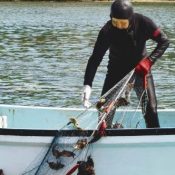
August 25, 2016 Hideaki Yoneda correspondent of Ryukyu Shimpo
An eighty-year-old fisherman in Tokashiki Village has practiced skin-dive fishing on his home island for more than 50 years. His name is Takemitsu Shinzato, a member of the Tokashiki Fisheries Cooperative, and he is known as a master of “homestretch” fishing, or Takemiiyachi. He continues to practice Okinawa’s traditional fishing on the island with a population of approximately 700 people.
Shinzato grew up with the influence of late his father Takeharu, who was the shipmaster of a bonito fishing ship. Shinzato has been fishing as a hobby since he was 30 years old. After retiring from his job at the National Okinawa Youth House twenty years ago, he became a full-time fisherman. His catch is used for meals that his wife Katsuko serves at her restaurant.
Shinzato owns one big sabani (Okinawan canoe) and a small boat. As he says, “It is only me who sets up the net for fishing.” He gets out on the boat, wears a wetsuit, a mask, fins, and weights. Then he dives to set up the net, directs fish into the net, and catches the fish. It is a physically and mentally demanding way to catch fish.
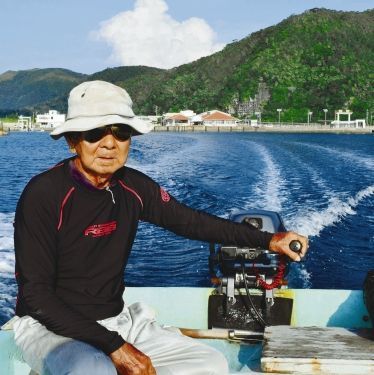
Shinzato gets out for fishing on his favorite small boat.
There are cracks everywhere at the bottom of the ocean, which is filled with coral reefs. Holding a 1.8-meter high, 30-meter long net, Shinzato dives to the bottom of the ocean. He stretches out and secures both ends of the net to coral. After putting weights on the net, the preparation is done.
When the tide changes, fish gather in the deep cracks of coral reefs. Shinzato takes a deep breath in and dives to a depth of seven to eight meters below the surface of the sea. He quietly guides schools of fish such as Irabucha, Egwa, Kusuku, Katakashi, and then quickly pushes them into the net.
Once he dives into the water, he does not take another breath for a couple of minutes until fish get caught in his net. He sets up a net six or seven times a day. Sometimes, the volume of landings exceeds 100 kilograms.
Shinzato is also good at catching shellfish and octopus. He has also caught a wild goat at the beach before. When he is not out fishing, he does volunteer work for the community. He won first place in the 5-kilometer Tokashiki Marathon in the 75 years and above age group. Community residents are impressed by him, saying, “He is a super grandpa, who does not seem 80 years old.”
Shinzato teaches homestretch fishing to students and visitors at the Youth House. He smiled and said, “I would like to continue fishing for the community as long as I am physically capable.”
(English translation by T&CT and Megumi Chibana)
Go to Japanese
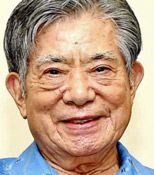
September 3, 2016 Ryukyu Shimpo
The Hawaii United Okinawa Association (HUOA), led by President Tom Yamamoto, will give its 2016 legacy award to National Living Treasure of Japan Choichi Terukina, 84, who lives in Naha City. The HUOA presents the legacy award annually to honor individuals who have made significant contributions to the Okinawan descent community.
Terukina is recognized for his achievements in promoting Ryukyu traditional music in Hawaii. The Hawaii affiliate of the Ryukyu Koten Afuso Ryu Ongaku Kenkyu Choichi Kai led by Terukina was established in 1984 and has now about 100 members.
Terukina said, “This award is a great delight for me. My hope to have Okinawan performing arts take root in Hawaii has borne fruit. Hawaii is a foreign country but we [Okinawan descent community] have the same root. I want to teach performing arts that make the hearts of performers and audience become one.”
The award presentation ceremony will be held on December 4 at a hotel in Honolulu City.
(English translation by T&CT)
Go to Japanese
September 2, 2016 Ryukyu Shimpo
Six Japanese NGOs, including the Nature Conservation Society of Japan, jointly submitted a recommendation to the International Union for Conservation of Nature (IUCN) on how to deal with invasive species that will be introduced during construction of a new base in Henoko. The IUCN adopted this recommendation by a majority vote.
In regards to construction of a new base in Henoko the IUCN recommends establishing a means to resist the introduction of invasive species mixed in with materials for land reclamation. The recommendation is requesting that the Japanese government establish a method of preemptively detecting invasive species mixed in with the soil for land reclamation, and appealing for the U.S. government to choose adequate means to protect against invasive species.
One could say that by putting up such a high hurdle in the way of land reclamation work related to new base construction in Henoko, the recommendation is actually pressuring the U.S. and Japanese governments to abandon construction.
Construction of the new base will require 21 million cubic meters of soil, enough to fill the Okinawa Prefectural Office 70 times, 17 million tons of which will be hauled in from Kyushu and Shikoku. The locations outside Okinawa from which the soil will be collected are confirmed to be home to nine species that are poisonous or likely to be destructive to native species, such as the Argentine ant and redback spider.
It is nigh impossible for every single specimen of an invasive species to be detected in these large quantities of soil. There is no adequate method to protect against introduction of an invasive species, or to establish preemptive detection of these species in the soil.
The best method for protecting against the introduction of invasive species is to not haul soil from outside Okinawa. The only way for the Japanese government to abide by the IUCN recommendation is to abandon construction of a new base in Henoko.
Even if the recommendation is not legally binding, given that the Ministry of Foreign Affairs and Ministry of the Environment are members of the IUCN, the Japanese government has the duty and the responsibility to comply with the recommendation.
If the Japanese government disregards this IUCN recommendation as it has three times before with recommendations to protect Dugongs, because it did not share the same sentiments, Japan will lose the trust of the international community.
Japan hosted the 10th Convention on Biological Diversity in 2010, and compiled international goals to protect biodiversity called the Aichi Targets. These goals include conserving at least 17 percent of landmass, conserving at least 10 percent of the marine areas, and preventing extinction of any endangered species by 2020.
The Japanese government must not commit the foolishness of filling in the ocean where the new base is planned for construction, when that stretch of water should become a nature preserve.
The Ministry of the Environment designates the north central shoreline of Okinawa’s main island, including Henoko Bay, as an ocean area of high priority. The government should change its inconsistent posture of pursuing land reclamation in an ocean area that is valuable for its nature.
(English translation by T&CT and Erin Jones)
Go to Japanese
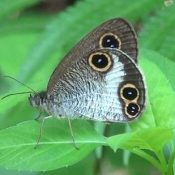
August 24, 2016 Ryukyu Shimpo
Ryukyu uranami janome, a butterfly species endemic to Okinawa prefecture and considered to be at risk of extinction, was found on the forest road next to the N1 zone gate to the U.S. military’s Northern Training Area on August 23. The area is a planned site for the construction of new U.S. helipads. Butterfly researcher who spotted the species, Akino Miyagi, pointed out that the forest road known as “N1-back,” where the construction is proceeding in Takae, Higashi village, is also a habitat for the species. She said, “The construction will lead to the destruction of the habitat. This is a dangerous scenario.”
Ryukyu uranami janome can only be found in northern Okinawa Island and Kerama islands. Ten butterflies were found during the survey on August 23.
Researcher Kazunobu Shirai, said, “The presence of the elementary species proves rich diversity.”
(English translation by T&CT and Sayaka Sakuma)
Go to Japanese
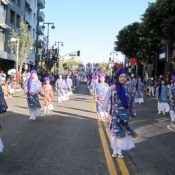
August 29, 2016 Sadao Tome, Correspondent of the Ryukyu Shimpo
The Nisei Week Japanese Festival, which started over 100 years ago with the theme of celebrating Nikkei culture and the local community, was held for the 76th time (it was cancelled for the period around World War II). The festival lasts for around one month, centered in Little Tokyo in downtown Los Angeles. The festival reached its peak at a parade held on August 14.
Selected as Grand Marshall of the parade was makeup artist Kaori Nara Turner, originally from Tokyo, who is well known in Okinawa. Selected as Parade Marshall was Japanese-American actress Brittany Ishibashi. Ishibashi has become well-known for playing a female ninja named Karai in the latest Ninja Turtles film.
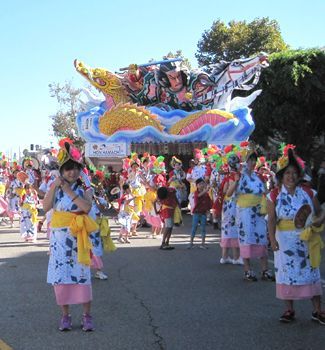
Aomori Nebuta Matsuri, the most festive scene at the parade
The queen of this year’s Nisei Week Festival was Jaclyn Tomita, representative from San Fernando Valley. She rode in the parade on a large float together with the princesses and the rest of the court.
Okinawan-descended Kitty Sankey, president of the Japanese Chamber of Commerce of Southern California, appeared in the parade in an open car and greeted the spectators with a smile. An Inspiration Award was bestowed upon John Tamaki, whose father was from Okinawa, and who made great contributions to the Japanese American community. Tamaki passed away suddenly in 2015 at the age of 53.
The Performing Arts Committee (Chairman: Yoshimichi Shinjo) of the Okinawa Association of North America (President: Shingi Kuniyoshi) combined Ryukyu dance and Ryukyukoku Matsuri Daiko with Okinawan rhythms, with a total of around 100 performers performing in the parade to cheers from the spectators.
(English translation by T&CT and Sandi Aritza)
Go to Japanese
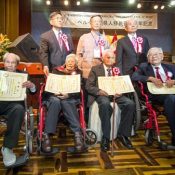
August 30, 2016 Ryukyu Shimpo
On August 28 (August 29 Japan time), a 110-year commemorative ceremony for Okinawans who immigrated to Peru opened at the Okinawan Association of Peru Center in Lima, Peru. About 600 people of Okinawan heritage attended the ceremony.
Governor of Okinawa Takeshi Onaga participated in the ceremony and shared some words thanking Okinawan pioneers’ hard work in establishing a community in Peru. He said, “You overcame obstacles with a persistent spirit, developing today’s Okinawan community and building its position.” In addition, he praised Okinawan immigrants that their contributions to the development of Peru make Okinawans in the prefecture proud.
Onaga awarded letters of appreciation to each of four Okinawans who emigrated over 100 years ago and their family members. The four who immigrated to Peru over 100 years ago are 108-year-old Zenson Nakahodo of Uruma City, 102-year-old Haru Ueda of Uruma City, 102-year-old Matsu Miyagi of Ogimi Village, and 102-year-old Shugen Ota of Motobu Town.
Chairman of the Okinawan Association of Peru Arturo Yara and 93-year-old Kisei Higa from Kitanakagusuku Village accepted letters of appreciation on behalf of the 80 Okinawans who immigrated to Peru over 90 years ago.
After these letters were conferred, Onaga encouraged attendees of the ceremony to come to the 6th Worldwide Uchinanchu Festival that will be held in October. He said that Okinawans are altogether waiting with open arms to receive many participants.
A stage was set up outside of the Center especially for commemorative performances. As part of the Kaiho Yoshu Network Building Program, five high school students and five university students from Okinawa came to Peru to help members of the Association run the ceremony and commemorative performances. More than 2000 people gathered by the stage to enjoy Okinawan traditional arts and various performances.
(English translation by T&CT and Erin Jones)
Go to Japanese

September 1, 2016 Ryukyu Shimpo
[Helipad coverage team] From 10:25 to 10:55 on the morning of September 1, the Okinawa Defense Bureau carried ten dump trucks of gravel through the gate to the N1 zone, one of the planned sites where new helipads are to be constructed as part of the plan to build new helipads (helicopter takeoff and landing strips) in the U.S. military’s Northern Training Area, which spans Higashi Village and Kunigami Village. Approximately 80 protesters opposing the construction engaged in actions to prevent vehicles carrying workers and the dump trucks from entering the N1 gate, stopping the vehicles along Prefectural Road 70 and engaging in sit-in actions. These actions delayed the work roughly two hours.
More than 200 police and riot squad members forcibly removed the sit-in protesters one by one. For roughly two hours, the police blocked the road and otherwise restricted traffic at multiple locations along Prefectural Road 70 in Takae, Higashi Village. Amidst fierce clashes between police and protesters, one protester had to be carried away in an ambulance when he began to feel unwell.
On September 1, it became procedurally possible to commence work on new helipads at the H and G zone locations. Therefore, it was thought that protesters’ tents might be removed at the so-called area “behind N1” in conjunction with the commencement of construction, and thus protesters guarded the tents throughout the night, remaining alert. The tents were not removed.
On September 1, 51 members of the Uruma branch of the All Okinawa Council came to Takae by bus, and so nearly twice the usual number of protesters engaged in actions to stop the dump trucks. Douglas Lummis (80) and five other members of the Ryukyu-Okinawa Branch of Veterans for Peace (VFP), a group made up of military veterans, also participated in the protests.
Around 6:30 on the morning of September 1, Hiroji Yamashiro of the Okinawa Peace Movement Center called upon people gathered at a rally in the area behind N1: “Now, construction might also start at the H and G zone locations. Let’s keep up the protest movement at those locations in addition to N1 and stop the construction from moving forward!”
(English translation by T&CT and Sandi Aritza)
Go to Japanese
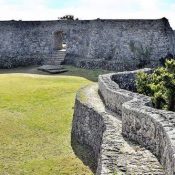
August 26, 2016 Ryukyu Shimpo
On August 25, TripAdvisor, the biggest travel review website in the world, announced the “Top 20 Japanese castles in 2016.” Nakagusuku castle ruins (covers Nakagusuku and Kitanakagusuku villages) ranked 10th and Katsuren castle ruin in Uruma City ranked 11th. Nakijin castle ruin ranked 13th, making the list for the first time, followed by Shurijo castle (14th) and Zakimi castle (18th). First place went to Himeji castle in Hyogo Prefecture.
One of the reviewers said, “The Nakijin castle ruin’s undulant wall is unique, reminding us of the Great Wall of China and providing a beautiful contrast with the green grasses around it.”
(English translation by T&CT)
Go to Japanese
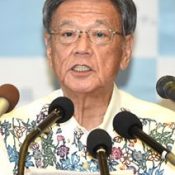
August 26, 2016 Ryukyu Shimpo
Governor Takeshi Onaga held a press conference on August 25 at the Okinawa Prefectural Office. At the conference he pointed out that, “Whether 500 or 800 officers are mobilized, it will certainly be excessive policing,” referring to the ongoing state of tension between Okinawans and the riot police surrounding helipad construction in Takae.
The Okinawa Prefectural Public Safety Commission, the members of which Onaga has the power to appoint, appealed for the dispatch of riot police officers from outside of Okinawa. Onaga said it was a terrible shame that the Commission made this appeal. He claimed that, “The [Prefectural] Public Safety Commission aught to be [an entity] recognized for its neutrality, exemplifying fairness, impartiality, and independence.”
During the conference Onaga criticized the Japanese government for resuming construction of the relocation facility for Futenma Air Station. He said that the government is far from assuming a posture of closely associating with Okinawans and communicating frankly with them.
Onaga claimed that the deforestation and red soil erosion caused by helipad construction fall under laws and regulations on these issues. He said that since Japan is a constitutional nation, he wants the central government to follow these laws and regulations properly. In addition, he mentioned that the Okinawa Prefectural Government had been requesting the Japanese government to withdraw Osprey from Okinawa. Therefore, he claimed, “If the government fails to provide a careful explanation about our request, I think that goes against the relationship of mutual trust [between Okinawa and Japan].” Following this, he once again requested withdrawal of Osprey aircraft from Okinawa.
(English translation by T&CT and Erin Jones)
Go to Japanese
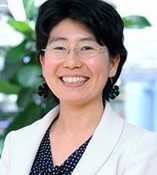
August 26, 2016 Ryukyu Shimpo
On August 25, Governor Takeshi Onaga announced that the eighth Okinawa Peace Award will be given to the Japan Association for Refugees (JAR), a registered NPO based in Tokyo and headed by Eri Ishikawa. The Okinawa Peace Award is presented to individuals and organizations engaged in activities that contribute to the construction and maintenance of peace in the Asia-Pacific region.
JAR works to support each and every refugee, helping them with the procedures required to obtain refugee status and ensuring that they have access to health care, food and shelter from the time that they arrive in Japan until they are able to regain independence. It receives consultations from roughly 600 people in around 60 countries each year. It cooperates and works together with governments and local organizations in various countries in the Asia-Pacific region.
The Okinawa Peace Award Committee Selection Committee, chaired by Mitsubishi Research Institute board member Hiroshi Komiyama, explained that JAR was selected because “The spirit of mutual assistance and ‘achieving a society where multiple cultures coexist’ which is at the root of their activities is in accord with the spirit of the Okinawa Peace Award, which was founded upon Okinawa’s historical and cultural features, including the experience of the Battle of Okinawa and other hardships, and the acceptance of various cultures.”
The Award was founded in 2002, and is presented once every two years. This is the first time a recipient has been decided since Governor Onaga took office. “I would like to see Okinawa’s spirit conveyed to the world, especially the Asia-Pacific region, and for people to learn about what Okinawa is like. I hope that the Award gains visibility and continues to be presented,” said Onaga.
The award ceremony will be held at the Loisir Hotel Naha in Naha City on October 31.
Eri Ishikawa
――――――――――――――――――
Achieving peace and non-violence from Japan
Eri Ishikawa, Chair of the Board of the Japan Association for Refugees (JAR)
I want to share my happiness at being presented this award with the refugees and supporters I work with. Refugees who have fled to escape conflict and human rights abuses help us reaffirm the value of peace, freedom and democracy. I hope to continue to contribute from Japan to achieve even better support for the sake of refugees, and to achieve a world of peace and non-violence together with refugees.
(English translation by T&CT and Sandi Aritza)
Go to Japanese











 Webcam(Kokusai Street)
Webcam(Kokusai Street)


